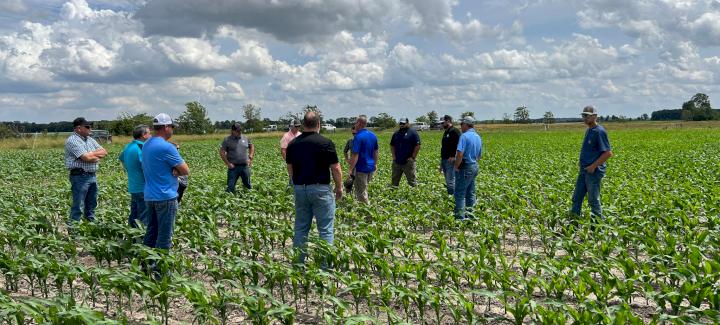
At Stine, our agronomy department is focused on the future and has a full agenda for the 2023 farming season. From planting to harvest, our agronomy team’s goal is to conduct more in-field analysis of product performance, including the hybrids and varieties that have advanced to our Elite Yield Trials and are close to commercialization.
“Previously, we focused more on current product offerings and their performance in our sales territories,” says Tom Larson, director of agronomy. “That will still be a part of our strategy moving forward, but this year we’re going to spend more time with the products in our Elite Yield Trials so that we can gain information that will aid in the selection process of future products.”
PRODUCT DEVELOPMENT PLOTS
Stine® agronomy has coined this research as the Product Development Plot program — an effort that will allow us to review all Stine germplasm from our Elite Yield Trials through replicated strip trial plots throughout the country.
“Our agronomy team will be charged with managing the entire program — from finding the locations for each plot to getting the seed ready, planting the plots, taking notes and checking yields,” says Larson. “We’ll also use the plots to train our sales team on how these new products will perform in their regions so that nothing is left to interpretation.”
Plot setup
To ensure consistency in research, the agronomy team has strict guidelines in place. Each corn plot will be planted by height or maturity with a minimum of 12 row plots with the center six rows harvested. Each side of the plot will have a 15-foot barrier to minimize risk of outside factors coming into the field.
“Our goal with only harvesting the centers of our corn plots is to eliminate the potential for shading or any other outside influence along the field barriers that can impact yield,” says Larson. “This is especially true for corn as Stine has shorter-stature material compared to competitors. We want a true sampling of these products.”
Each corn plot length has a 300-foot minimum. The agronomy team will test both glyphosate and non-glyphosate plots. They’ve also nailed down specific dates for the plot seed to be bagged and shipped to ensure its timely arrival for planting. Agronomists will also conduct Stine’s emergence study at these plots to evaluate corn emergence to demonstrate how uniform emergence impacts ears and yield.
On the soybean side, plots will be planted by maturity, with a minimum of eight rows and a plot length of 400-feet. The planting population for each plot will be 140k/acre.
“Our goal is to have a total of 30 corn and 30 soybean plots planted throughout our sales territory at a minimum,” says Larson. We want to make sure the products perform the way we expect them to. And, of course, we’ll compare them to competitor hybrids and varieties of similar maturity for an even playing ground.”
Data collected
All agronomic data will be collected by the agronomy team. Specifically, for corn they will look at emergence scores as they relate to seed treatments; disease ratings; general plant observations; plant, ear, leaf and tassel height; silking and pollination dates; test weight, moisture and yield; and harvestable ear percentage. For soybeans, they’ll look at emergence scores; disease ratings; general plant observations; vegetive/pod development; pollination; moisture; and yield.
“Stine agronomists will also offer two agronomy training sessions for our sales team per Stine region to ensure they’re equipped with the right facts and messaging about each product,” says Larson. “Our goal is not only to see how these products perform for our own knowledge, but also to gather all possible data prior to commercialization so that we’re better able to place the products in growers’ fields.
Stay tuned for next week’s agronomic outlook article; we’ll be discussing Stine’s Success Demo Plots. To connect with a Stine agronomist, contact us here.
Related Articles
-

Start strong with Stine®: Maximizing your 2026 potential
January 2026 in Agronomy
-

Stine® to offer Syngenta’s Victrato® soybean seed treatment in 2026
December 2025 in Agronomy
-

Use Stine’s XP® seed treatments to prevent early injury to your crops
December 2025 in Agronomy
-

Understanding Stine’s enhanced oil profile soybeans
December 2025 in Agronomy



